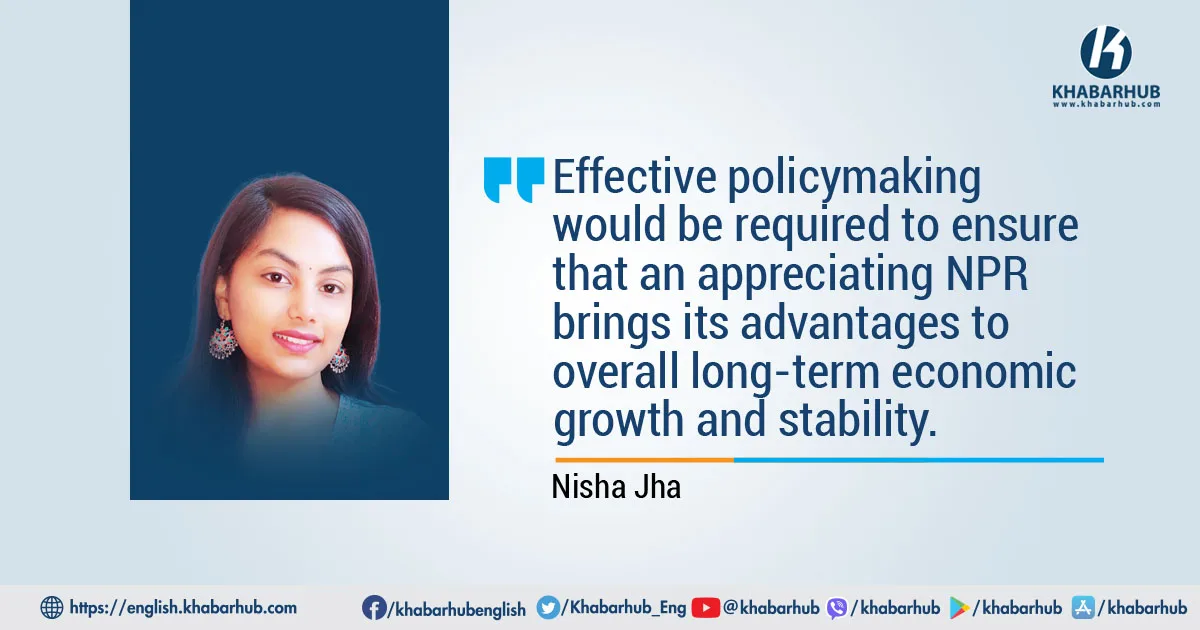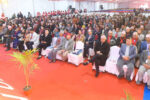Tiny but noticeable rise in value of the Nepalese Rupee (NPR) compared to the US Dollar has an impact on key economic factors.
This routine change in currency rates has an influence on foreign direct investment (FDI), the balance of payments (BOP), inflation, and how Nepalese people live their daily lives.
Despite what many think, a more robust NPR can draw more foreign direct investment.
When someone from another country brings dollars to Nepal, they swap their dollars for rupees at the central bank. Let’s look at two cases: in one, 1 USD equals 100 NPR; in the other, 1 USD equals 200 NPR.
In the first case, an investor trades 1,000 USD and gets 100,000 NPR. In the second case, the same 1,000 USD gives them 200,000 NPR.
With more rupees for the same amount of dollars, the investor might earn better returns on their investments in Nepal.
This makes the country more appealing for FDI, as foreign money can go further and make more profit. This means the inflow of dollars can boost FDI helping the economy grow and progress.
Also, a stronger NPR has an impact on the import bill making imports less expensive and increasing the import volume.
Inflation, as a persistent rise in the general price level of goods and services, goes deep into the economy, especially to the common people. Here’s a closer look at how these economic pressures manifest in daily life.
Let’s look at an example to understand this: Picture Nepal importing 1,000 smartphones from the US, each costing 200 USD.
When 1 USD equals 200 NPR: Cost per smartphone in NPR = 200 USD * 200 NPR/USD = 40,000 NPR Total cost for 1,000 smartphones = 40,000 NPR * 1,000 = 40,000,000 NPR
When 1 USD equals 100 NPR: Cost per smartphone in NPR = 200 USD * 100 NPR/USD = 20,000 NPR Total cost for 1,000 smartphones = 20,000 NPR * 1,000 = 20,000,000 NPR In the first case, the stronger
NPR (1 USD = 100 NPR) means that the same 200 USD per smartphone costs 20,000 NPR instead of 40,000 NPR. This lower cost per unit can prompt Nepalese importers to purchase more leading to a rise in the total volume of imports. When foreign products cost less, people and companies might buy more of them causing the total import expenses to go up.
This higher demand for goods from other countries can hurt the balance of payments resulting in a trade deficit.
A trade deficit is the amount by which the value of a country’s imports exceeds the value of its exports. It affects country’s economy in various ways
Foreign Exchange Reserves: Subsisting trade deficits tend to deplete foreign exchange reserves for Nepal.
By virtue of the fact that the country pays for its imports in foreign currency, it strains the country’s reserves and consequently affects its ability to manage the value of its currency and meet international financial obligations.
Currency Depreciation: A high trade deficit may exert downward pressure on the NPR. Should demand of foreign currency exceeds supply, the value of NPR may go down, which might reduce some of the appreciation benefits gained initially.
Economic Growth: Thus, if any country depends largely on imports, domestic industries and business entities continue to spoil, as these relatively cheaper foreign goods, apparently, defeat local products.
This would tend to make it difficult for domestic manufacturing and farming sectors to grow and could result in lost jobs and a slowing down of economic growth.
Debt Levels: Financing this trade deficit may involve borrowing from foreign lenders, increasing the country’s external debt.
Higher debt levels incur heavier interest payments and rob the amount that remains available for domestic investment in important sectors like infrastructure, education, and health.
Inflation: Though very short term may depict reduced prices due to cheaper imports, a persistent trade deficit can lead to inflation as may be witnessed when the country’s currency sharply depreciates.
More expensive imported goods lead to higher price levels.
Investor Confidence: A continued trade deficit depletes investor confidence in a country’s economy; if investors believe it is pointing towards instability, most will shy away from making investments in the country, thereby exacerbating the existing economic problems.
In people’s and companies’ navigations through a rising price and uncertain cost environment, the very stability of the economy is put into jeopardy.
At a time when Nepal is struggling with a growing trade deficit and rising inflation, the brunt of it all is being felt in the everyday lives of its citizens.
Inflation, as a persistent rise in the general price level of goods and services, goes deep into the economy, especially to the common people. Here’s a closer look at how these economic pressures manifest in daily life.
Rise in Cost of Living: One of the most direct effects of inflation is that it increases the cost of living. With prices suddenly shooting up in all these basic essential goods—food, fuel, and housing—Nepalese families have to spend a larger portion of their income just to keep themselves up with the primary necessities of life.
This diminished value of money, therefore, lowers their purchasing power and diminishes the quality of life, hence significantly impeding households from sustaining the standard of living.
Higher Prices of Imported Goods: It also means that inflation hits the cost of imported goods.
While a stronger NPR would make imports cheaper, persistent inflation will reverse such trends.
With depreciation or increases in world prices, imported products—ranging from consumer electronics to clothing—rise in price.
This increase in price hits directly at households who rely on these goods, making everyday items less affordable and putting additional stress on family budgets.
Erosion of Savings: Inflation erodes real savings values, which poses quite significant problems for those living on fixed-income savings or pensions.
As prices go up, the real purchasing power of money saved falls, consequently making it hard to maintain a comparable level of living.
Perhaps savings no longer go as far as they once did, thereby adding to financial stress and less economic security.
Interest Rates and Borrowing Costs: The central bank may respond by raising interest rates to try and curb inflation.
Such a move will not only control inflation, but it also makes it more costly to borrow for both individuals and businesses.
Families are burdened with higher costs of mortgages and loans, which pinches household pockets.
Inflation control, through efficient monetary policies, would call for adjustments in interest rates and prices to avoid the erosion of purchasing power.
For businesses, it results in higher prices for goods and services, a tendency that may further accelerate the very factor that is meant to be curbed, thereby slowing down economic growth.
Uncertainty and Economic Instability: Inflation introduces into the economy a factor of uncertainty, which makes it hard for people and businesses to plan for the future.
This uncertainties in the expectations of consumers and investors add to dampening spending or investment, slowing down growth, and could result even in job losses.
In people’s and companies’ navigations through a rising price and uncertain cost environment, the very stability of the economy is put into jeopardy.
The everyday living of people in Nepal is affected by the multi-dimensional and wide-ranging effects of inflation.
Spiraling living costs, erosion of savings, and increased borrowing costs all combine to make life difficult for citizens to digest.
As policymakers work on the solution to these economic problems, it shall be equally important to consider their ramifications for the common man, work on their remedy, and strive for stability in the economy and protection of Nepalese family well-being.
Weighing and balancing the benefits against the drawbacks of a stronger Nepalese Rupee is quite challenging while Nepal grapples with its implications.
On the other hand, an appreciation in NPR will definitely enhance the attractiveness of Nepal as an FDI destination since foreign investors find better values for their dollars, which can spur more investments to drive economic growth.
This benefit should, however be considered with other expected drawbacks that include reduced competitiveness of the Nepalese exports.
With the appreciation of NPR, the goods of Nepal become dear to foreign buyers, and a decrease in export demand is likely to hit export-oriented industries.
Indeed, appreciation can further deteriorate the trade balance in the case that falling export revenues as a consequence of falling export competitiveness and increasing imports, the result of cheaper foreign goods, result in an overstretched BOP.
Essentially, a detailed economic policy designed to stabilize the NPR, strengthen key sectors, and keep inflation in check would make Nepal more resilient and prosperous.
There is no doubt that such a scenario could prove very draining on foreign exchange reserves and throw the economy off balance.
In this respect, policies are required that aim at enhancing domestic production and bridging import dependence.
The other critical concern is inflation. Higher import volumes may mean higher inflation in the case of currency depreciation or rising global prices.
Inflation control, through efficient monetary policies, would call for adjustments in interest rates and prices to avoid the erosion of purchasing power.
In the final analysis, appreciation of the Nepalese Rupee presents opportunities and challenges to the economy of Nepal.
A stronger NPR would be more attractive to FDI, possibly leading to higher economic growth.
The negative offset with these gains is reduced competitiveness of Nepalese exports, coupled with a widening trade deficit likely to put pressure on the BOP.
These complexities would need proper management in a very balanced manner if Nepal has to sail through them.
Offset measures for the loss accrued because of currency appreciation on trade by supportive sectors through export productivity enhancement and market diversification are equally necessary.
Additionally, management policies for the inflationary trend and the trade deficit would also become crucial for sustaining the base of economic stability.
Ultimately, this would be about reaping the gains of currency appreciation with prudent management of the associated negative side effects.
Essentially, a detailed economic policy designed to stabilize the NPR, strengthen key sectors, and keep inflation in check would make Nepal more resilient and prosperous.
Effective policymaking would be required to ensure that an appreciating NPR brings its advantages to overall long-term economic growth and stability.









Comment